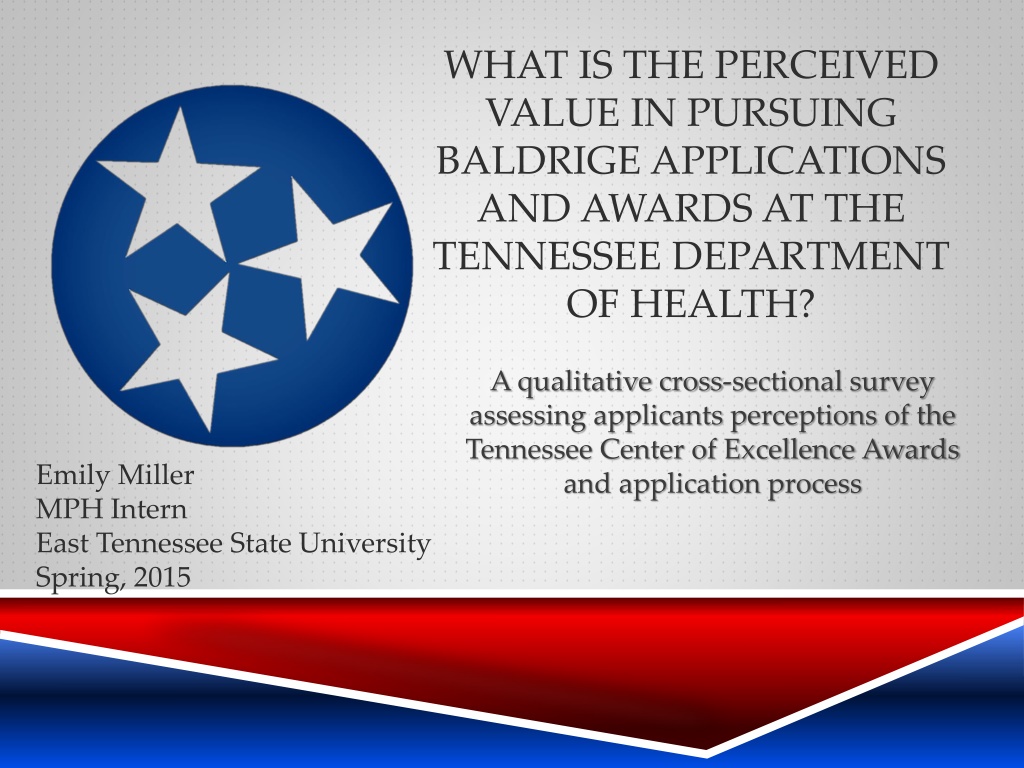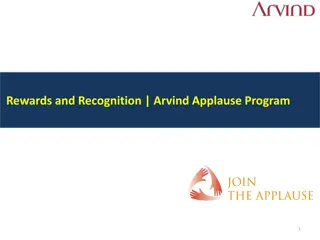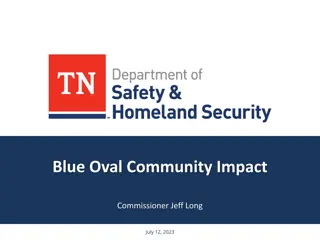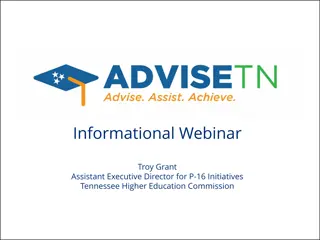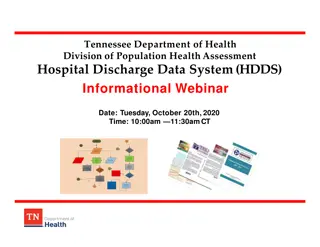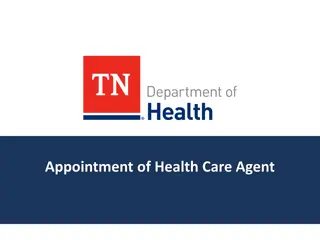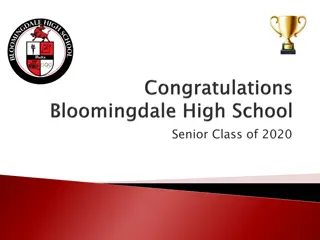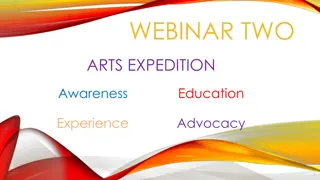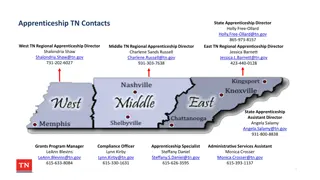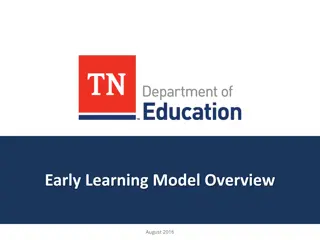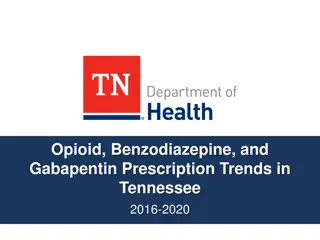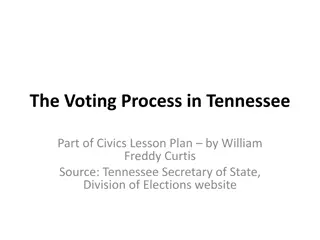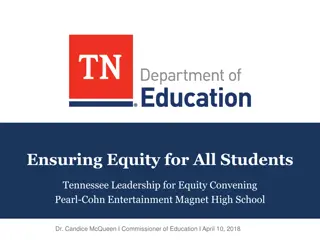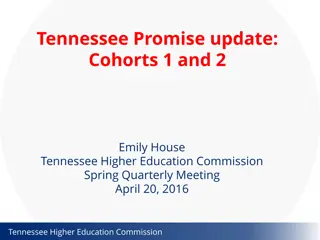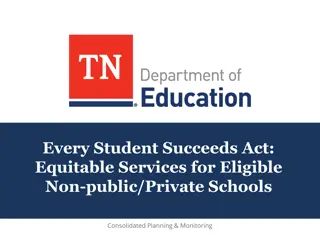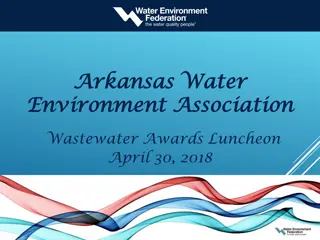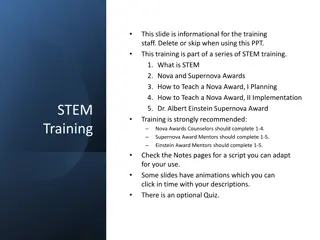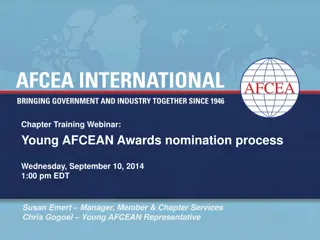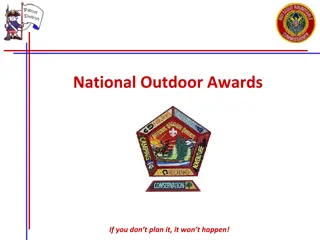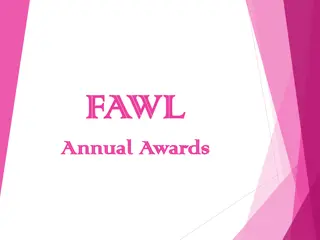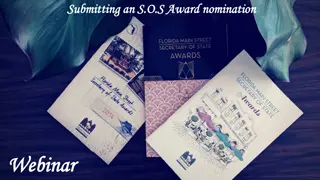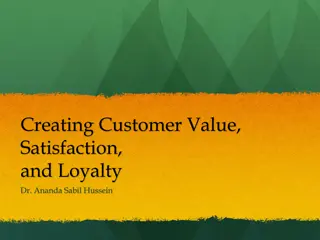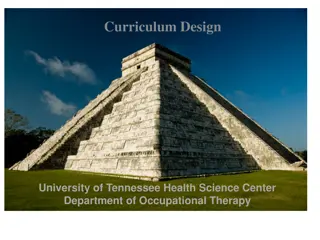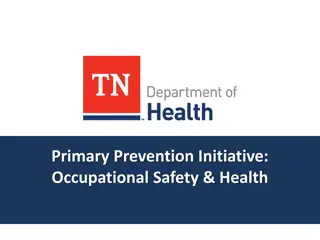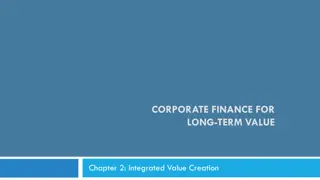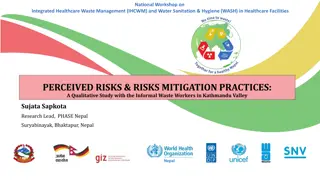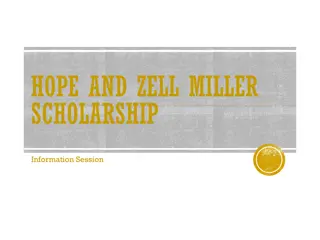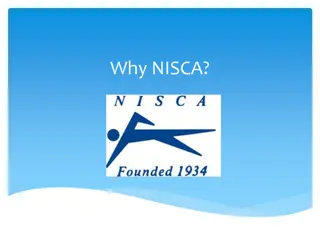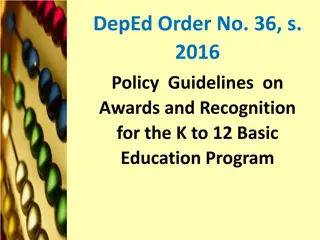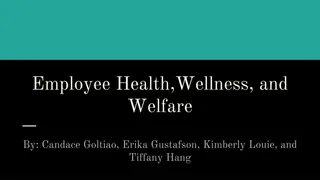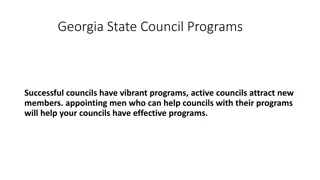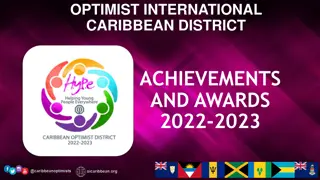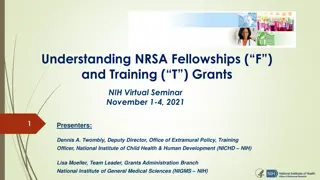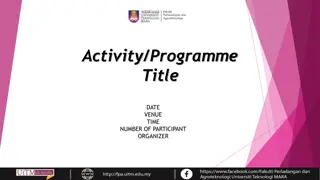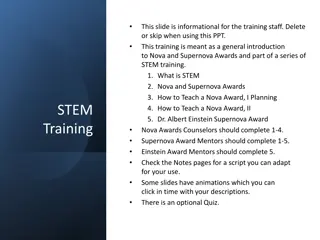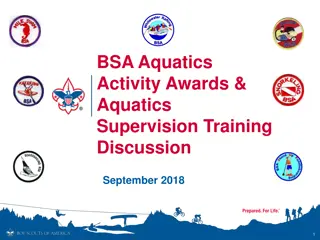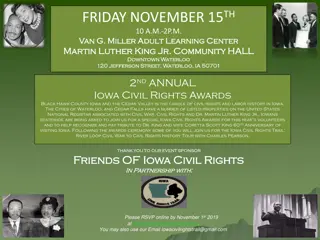Perceived Value of Pursuing Baldrige Applications and Awards at Tennessee Department of Health
Qualitative cross-sectional survey by Emily Miller, MPH Intern at East Tennessee State University, explores applicant perceptions of pursuing Tennessee Center of Excellence Awards and the application process at the Tennessee Department of Health. The study delves into the mission, background of Baldrige and TNCPE, and the benefits of uniformity in assessments for achieving excellence in healthcare services in Tennessee.
- Tennessee Department of Health
- Baldrige Applications
- Awards
- Tennessee Center of Excellence
- Healthcare Excellence
Download Presentation

Please find below an Image/Link to download the presentation.
The content on the website is provided AS IS for your information and personal use only. It may not be sold, licensed, or shared on other websites without obtaining consent from the author. Download presentation by click this link. If you encounter any issues during the download, it is possible that the publisher has removed the file from their server.
E N D
Presentation Transcript
WHAT IS THE PERCEIVED VALUE IN PURSUING BALDRIGE APPLICATIONS AND AWARDS AT THE TENNESSEE DEPARTMENT OF HEALTH? A qualitative cross-sectional survey assessing applicants perceptions of the Tennessee Center of Excellence Awards and application process Emily Miller MPH Intern East Tennessee State University Spring, 2015
INTRODUCTION Mission: Protect, Promote and Improve the health and prosperity of people in Tennessee Strive for excellence in the Department of Health Foster and Encourage Local and Regionals Offices Tennessee Centers for Performance Excellence
BACKGROUND Baldrige TNCPE Uniformity
BACKGROUND Baldrige Performance Excellence Program Established by Congress in 1987 Purpose: to enhance U.S. business competitiveness in a global economy by: Identifying and recognizing role-model businesses Establishing criteria for evaluating improvement efforts Disseminating and sharing best practices Internationally recognized and emulated National resource
BACKGROUND Baldrige Results from other studies suggest that there is increase benefit in the Baldrige process when organizations employ the suggestions and work through application as a unit.
BACKGROUND Tennessee Centers for Excellence Helps organizations run better. Holistic assessment Empower organizations-reach goals, improve results, become more competitive, reach goals Identify what really matters Focus efforts Breaks down criteria makes things simpler
BACKGROUND Tennessee Centers for Excellence Provides resources Aligns planes, processes, decisions, people, actions, results Ask WHY? Makes TN a better place to live and work
BACKGROUND Uniformity As the State of TN strives to make itself a better place to live, work, and play, a uniform way of measuring this is needed in order to achieve this goal. Currently Health departments across the state are ran by individuals from a many different backgrounds Across the board standards put in place to check and assess that goals and objectives are being met with excellence.
PURPOSE OF THIS STUDY Assess the common themes in applicant s perceptions of the Baldrige framework to promote organizational performance Identify issues that might prevent other counties from applying Determine next steps
METHODS Survey Questions developed Phone interviews Themes analyzed Identifying perceptions Comparing process to outcome
METHODS Survey Questions were developed after analyzing the applications and other reviewed materials Review by experts (Mr. Bruce Behringer and Mr. Adam Jarvis) Phone interviews 20 minutes with 15 leaders in Local, Regional, and Metro Health Departments/Offices
METHODS Themes analyzed Perceptions were gathered and classified as a theme based upon open-ended responses Themes in application process were compared to themes identified in outcome
METHODS Perceptions Direct questions clarified perceptions Themes gathered from open-ended responses Certain verbiage and phrase were classified under a theme
SURVEY RESULTS Overall Perception Value is found Top Themes TIME!!
SURVEY RESULTS Survey Outcome Process Themes Outcome Themes Cohesion Communication Outreach Eye-opening Compilation Improve staff Collaboration Empower Coordination Recognition
THE LOGIC MODEL INPUTS OUTPUTS Application Process Situation Outcomes Excellence Process Themes Cohesion Outreach Compilation Collaboration Coordination Outcome Themes Communication Eye-opening Improve staff Empower Recognition Assessing Improving Evaluating Reporting
THE LOGIC MODEL Issues INPUTS OUTPUTS Application Process Situation Outcomes Excellence Process Themes Cohesion Outreach Compilation Collaboration Coordination Outcome Themes Communication Eye-opening Improve staff Empower Recognition Assessing Improving Evaluating Reporting
SURVEY RESULTS Issues Time Subjectivity Buy-in Clarity Data availability Guidance Consistency See Table 6 for further explanation
Table 1: How individuals described the process for completing their application Themes Description Count Individuals who actually put the application together; they wrote it Compiled 14 Individuals who claimed responsibility for ensuring all aspects of the application were addressed Individuals who agreed the Tennessee Department of Health Mission and Vision statements were helpful and they used this statement to form their own. Individuals who pooled ideas from different people in order to complete the application Individuals who brought full staff in on some level during the application process Individuals who expressed a level of team work. Working with those within their organization to complete their application Individuals who organized and delegated responsibilities to others to complete sections of the application Individual who actively reached out to individuals and/or entities for assistance to complete their application Responsible 14 Mission and Vision agreement Included multiple ideas Involved whole staff 14 11 8 Collaboration 7 Coordination 7 Outreach 7
Figure 1: How individuals expressed their process 16 14 14 14 14 11 12 10 8 7 7 7 8 6 4 2 0
Table 2: How individuals expressed how prepared they were prior to the application process Themes Description Mean Level of training prior to completing application on a scale 1. No training 2. Some training/ feedback 3. Advanced training 4. Advanced training and experience Level of preparation 2.466
Table 2: Barriers for individuals while completing their application(s) Description Themes Count Individuals who noted this section of the application was difficult to complete and/or explain to examiners Strategic plan 4 Individuals who said identifying where patients were going for certain services was an issue Patients leaving 2 Individuals who noted this section of the application was difficult to complete and/or explain to examiners Results section 9 Individuals who noted this section of the application was difficult to complete and/or explain to examiners Customer Engagement 4 Individuals who noted this section of the application was difficult to complete and/or explain to examiners mainly due to mandated or lack of control over certain relationships (ie HRSA or CDC) Improving Suppliers and Partners 2 Workforce engagement Individuals who noted this section of the application was difficult to complete and/or explain to examiners 3
Figure 2: Top issues that arose for individuals while completing their application(s) 10 9 9 8 7 6 5 4 4 4 3 3 2 2 2 1 0
Table 3: Identified points related to the site visit Description Themes Count Individuals who identified as being unable to answer or address issues the examiners recommended based on mandates and governmental procedures that are out of the particular organization s control Individuals who said it was good for their organization to take the time to examine their organization Individuals who said it was a helpful way to show their staff the why behind an individual employee s tasks NEGATIVE: Specific processes out of organizations control 12 Ability to stop and evaluate 8 Review with staff the purpose of procedures 7 Individuals who identified the list of questions provided as a beneficial way to prepare and review with staff what they were expected to provide to the examiners A list of questions provided prior to site visit 6 Individuals who thought they were unable to fully communicate with the examiners who were analyzing their organization; disconnect based on language or understanding of certain processes Individuals who said it was a good to share their organization with others from outside of the health department NEGATIVE: Trouble with terminology 6 Sharing with others 4 Examiners were accommodating Individuals who felt the examiners were accommodating during the site visit 1
Table 3: Identified points related to the site visit 14 12 12 10 8 7 8 6 6 6 4 4 1 2 0
Table 4: Suggestions and wishes for improving their application Themes Description Count Individuals who would have like a clearer introduction and description of what to expect; link with other organizations who have or are currently going through the same process; better explanation of verbiage Individuals who would like clear data to address their needs and give backing to results section and direction for future plans Individuals who would like to know who to ask for certain questions they may come across as they complete their application Better introduction 12 Data 9 Improve process of asking questions 8 Individuals who would like a fillable template or examples of how an application should look and what to include in specific sections. Individuals who would like to have follow up and support on how to improve based upon feedback Individuals who think it is appropriate to have help/ attendance from individuals from central office for their site visit Official template 4 Training after Feedback Central office attendance to site visit 3 1
Figure 4: Suggestions and wishes for improving their application 14 12 12 9 10 8 8 6 4 3 4 1 2 0
Table 5: Beneficial outcomes of the application process Themes Description Count Individuals who said the application process allowed them to pause and look at their organization and its processes and identify reasons behind task; revealed and concisely identified the strengths and weaknesses Individuals who said they felt they were given the opportunity to make improvements within their organization with a tool that would facilitate positive change Individuals who were proud to see their organization was recognized for their efforts Individuals who appreciated the open communication chain that was created because of this application process Individuals who saw increase customer satisfaction directly caused my changes created from the process Eye-opening 14 Empowerment 12 Recognition 10 Increased Communication Increased customer satisfaction 7 6 Individuals who found it beneficial for others from outside the health department to have a change to give some advice Individuals who appreciated the TNCPE workshops and the direct effect of skills they learned from these Outside advise 3 Helpful workshops 1
Figure 5: Beneficial outcomes of the application process 16 14 14 12 12 10 10 7 8 6 6 3 4 1 2 0
Table 6: Overall problems faced when applying Issues Themes Description Count Individuals who found the time needed and level of involvement necessary to complete this application a difficult addition to their daily responsibilities and duties Individuals who identified a lack of data to address their needs and give backing to results section and direction for future plans as a problem Individuals who expressed difficulty when explaining their organization to non-health department individuals; making it hard to explain, in the time given, the limitations their organization has, because they are a government entity and have to align with certain protocol that is mandated Individual who found it difficult to give general and specific information Time 10 Data 9 Subjectivity 5 Specific or General information 4
Figure 6: Overall problems face when applying 12 10 10 9 8 6 5 4 4 2 0 Information Time Subjectivity Data
Table 7: Future intent Themes Description Count Individuals who are moving on to the next level application in the future Continuing 15 Individuals who ultimately decided this is an overall good process Good 6
Figure 7: Future intent 16 15 14 12 10 8 6 6 4 2 0 Good Continuing
SURVEY RESULTS Base upon this survey we can view the perceived value of the Baldrige process as being one that improves: Communication Eye-opening Improve staff Empower Recognition
CORRELATIONS Buy-in and benefits Collaboration and perception
CORRELATIONS SAMPLE SIZE Excel sheet is available to enter the survey data Dummy variable created SAS code written in preparation for future study Fisher s test showed no correlation
STRENGTHS & LIMITATIONS Open ended questions Sample size Confidential
STRENGTHS & LIMITATIONS Open ended questions Open ended questions in an initial survey are both a strength and a limitation. With an initial or pilot styled survey it is important to cast a larger net or to allow available discussion in order to better address issues. Bivariate and categorical questions may be developed from these results
STRENGTHS & LIMITATIONS Sample size The small sample size reduces the statistical power of this study, so when analyzed there is no statistical significance. Additional participants or future studies are needed in order to find significance in results.
CONCLUSIONS This study showed: Improved communication Grouped efforts Overall VALUE is backed by participants
CONCLUSIONS Overall VALUE is backed by participants Individuals who said the application process allowed them to pause and look at their organization and its processes and identify reasons behind task; revealed and concisely identified the strengths and weaknesses Individuals who said they felt they were given the opportunity to make improvements within their organization with a tool that would facilitate positive change Individuals who were proud to see their organization was recognized for their efforts Individuals who appreciated the open communication chain that was created because of this application process Individuals who saw increase customer satisfaction directly caused my changes created from the process Individuals who found it beneficial for others from outside the health department to have a change to give some advice Individuals who appreciated the TNCPE workshops and the direct effect of skills they learned from these Eye-opening Empowerment Recognition Increased Communication Increased customer satisfaction Outside advise Helpful workshops
DISCUSSION Recommendations Future direction Support Comparison Data Communication
DISCUSSION Recommendations As individuals are stretched to add task to their work load the argument that this added work pays off in the end is backed by this interview/survey. Many argued that they cannot improve on some of the aspects they were asked to, because of certain mandates ( red tape ). Informing examiners about how a health department fits in the Health Care Framework will help when they are asking questions that seem to be for a private sector applicants. To increase buy-in, those involve in upper level decisions will need to explain why to organizations so applicant are better prepared to answer examiners questioning. Provide individuals with results from
DISCUSSION Support The biggest barriers are the time, lack of subjectivity, and lack of comparison data. Increasing the availability of comparison data for organization will support them through the application process The already increase in communication has been see as a benefit in this process, however continued communication is necessary on multiple levels--within, between, and throughout the organizations
REFERENCES Citations: Hertz, H. (2012). The Impact of Baldrige on Organizational Performance. The Journal for Quality & Participation, 4-7. Retrieved February 10, 2015, from www.asq.org/pub/jqp Krueger, T. M., Wrolstad, M. A. (2013). Is It a Good Investment Strategy to Invest in Malcolm Baldrige Award Winners?: An Update. Journal of Finance Issues, 1-15. Vol. 12 Neville T. Duarte, Jane R. Goodson and T-Michael P. Dougherty. "Managing innovation in hospitals and health systems: Lessons from the Malcolm Baldrige National Quality Award Winners." International Journal of Healthcare Management 2013; 7(1), 21-34. DOI: 10.1179/2047971913Y.0000000052 Nevalainen D, Berte L, Kraft C, Leigh E, Picaso L, Morgan T. Evaluating laboratory performance on quality indicators with the six sigma scale. Arch Pathol Lab Med. 2000 Apr;124(4):516-9. PubMed PMID: 10747306. Swick L. Team-based organization: the fruits of employee empowerment. Hosp Mater Manage Q. 1997 Nov;19(2):1-3. PubMed PMID: 10173989. Survey Participants
THANK YOU!!! QUESTIONS? GO BUCS
